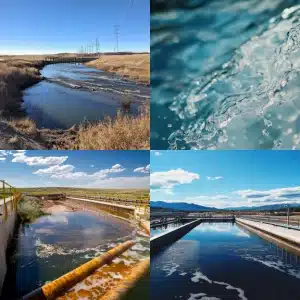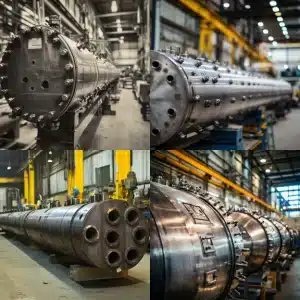Drinking water quality standards protect public health by limiting harmful contaminants, and Red River upholds these standards with the same precision used in their ASME-certified pressure vessel manufacturing. Regular testing, proper filtration, and reliable treatment systems often supported by pressure vessels ensure households receive safe, clean drinking water.
The Reason to Commit to Drinking Water Quality Standards
At Red River, we know that every aspect of our work whether manufacturing pressure vessels or ensuring safe water for customers and employees demands the highest standards. For this reason, drinking water quality standards play a crucial role in protecting public health and safety. These rules establish pollutant limits, ensuring the water you drink contains no harmful substances or is treated to meet strict safety levels. Therefore, strict adherence to these standards demonstrates our commitment to quality and safety. At Red River, we take pride in meeting regulatory compliance with care and precision, including our ASME-certified pressure vessels.
Public Health Protection
Water is vital for life, and ensuring its safety means keeping it free from pathogens, chemicals, and pollutants. However, contaminated water poses serious health risks, ranging from gastrointestinal infections to chronic diseases. Government regulations, like those related to drinking water quality, are crucial in protecting public health. These rules ensure water is tested, treated, and monitored to prevent harm from harmful microorganisms or contaminants. As a result, compliance reduces the risk of waterborne illnesses.
At Red River, we manufacture ASME-certified pressure vessels and offer prefabrication services to maintain reliability. Our commitment to drinking water standards reflects our dedication to safeguarding health and ensuring integrity in all that we do.
Avoiding Contamination
Contamination can occur anywhere along the supply chain, from the source to the tap. This is why providing safe drinking water requires rigorous monitoring of microbiological, chemical, and physical properties, reinforcing the importance of drinking water quality standards. At Red River, we recognize that contamination prevention is as critical to water safety as it is to pressure vessel manufacturing.
In addition, we lead the industry by addressing flaws in the materials and processes that ensure reliable, durable systems, including modular skid packages. When you partner with Red River, you gain access to cutting-edge solutions that prioritize safety and quality.
Basic Drinking Water Quality Standards and Guidelines
Fundamental Needs for Safe Drinking Water
Drinking water quality standards outline guidelines to ensure water is clean and safe. These standards cover several aspects, from biological hazards to chemical safety. Ultimately, compliance ensures public safety and reduces health risks.
Microbiological Standards
Microbiological standards focus on keeping drinking water free from harmful bacteria, viruses, and protozoa. Regular testing helps prevent diseases from sources like animals or untreated water supplies, supported by Red River pressure vessels.
Chemical Standards
Chemical standards regulate toxins such as lead, nitrates, and pesticides. High levels of these substances, even in small concentrations, pose long-term health risks. Complying with these standards keeps the water supply safe, especially when paired with our water treatment solutions.
Physical Standards
Physical standards address water clarity, taste, and smell. Water should be free from unpleasant odors, clear in appearance, and taste acceptable. These standards ensure water meets both aesthetic and safety expectations, reinforced by our quality-assured prefabrication processes.
Steps in Ensuring the Water Quality You Need
Safe, Potable Water in Every Home
Maintaining safe and potable water is crucial for your household’s well-being. Proactive water testing and selecting proper filtration systems are essential to ensure your water meets quality standards.
Testing Your Water Supply
The easiest way to ensure water safety is by testing your supply. Home testing kits measure common contaminants, including bacteria, lead, and nitrates. You can also submit water samples to certified labs for more detailed analysis.
If your household relies on a private well or comes from a potentially compromised source, frequent testing is crucial. Knowing the contaminants present helps you take corrective actions, ensuring your water is safe to drink. Learn more about water separation and treatment techniques.
Which Filtration Systems Should You Choose to Meet Drinking Water Quality Standards?
Once you know your water quality, choose a filtration system that addresses specific impurities. Filters with activated carbon remove chlorine and pesticides, while reverse osmosis systems eliminate heavy metals and bacteria.
Selecting the right filtration system depends on your household’s needs. Proper maintenance ensures efficient results, providing your family with safe, clean drinking water for years. Consider Red River’s modular skid solutions and pressure tanks for optimized water treatment at home or industrial facilities.
Need a reliable partner?
Red River specializes in the design and manufacturing of pressure vessels. We also fabricate related items such as prefabricated spools and skid packages.
Reach out to us today via our contact page and experience the Red River difference, where American-made quality and values come together to ensure safety and performance. Learn more about our capabilities and solutions to meet your unique water treatment needs.
Frequently Asked Questions
1. What Are the Most Common Contaminants in Drinking Water, and How Are They Regulated?
The most common contaminants in drinking water include microorganisms, such as bacteria, viruses, and protozoa; chemicals, like chlorine, lead, nitrates, and pesticides; and physical impurities, including sediments and organic matter. Each contaminant has an established standard under government drinking water standards that ensures it stays at a safe level. For example, many substances have MCLs set by the EPA, meaning they can’t exceed particular concentrations and, consequently, represent a public health risk. To determine that water complies with these strict guidelines, water utilities have to monitor the water regularly.
2. How Often Should Drinking Water Quality Be Assessed?
If you get your water from a public supply, it’s regularly tested by the utility; you may be able to get copies of reports detailing its quality. For a private well, testing at least annually is suggested, but more often if you detect changes in taste, color, or odor. In particular, tests must be done in case a well has newly been drilled or after flooding or any other type of incident that may pose threats to the water source.
3. What Is the Role of Pressure Vessels in Water Treatment?
Pressure vessels play a vital role in so many phases of water treatment, particularly when using filtration and storage. Infiltration systems with pressure vessels house the membrane or filter infused with chemicals or microbes to remove impurities within the water. They are designed to bear high pressures to ensure that filtration systems work smoothly and consistently. Pressure vessels are also utilized for water treatment storage under certain pressures; they, therefore, provide a continuous supply of clean water at all times. Advanced pressure vessels, manufactured to ASME specifications, are necessary for safeguarding the integrity of the process of water treatment.
4. Are Household Filtration Systems Capable of Removing All Contaminants Completely?
Most residential filtering systems activated carbon filters or reverse osmosis systems, for instance are very effective at removing most of the impurities that are in water, such as chlorine, lead, and many forms of bacteria. Unfortunately, no system is 100% effective, and you should select one appropriate to the contaminants that you know are present in your water. For instance, reverse osmosis is especially effective at removing heavy metals, and UV filtration is very good at destroying any pathogens that might be present in the water. Regular maintenance of these systems also allows them to perform at their best.
5. What Is the Difference Between Point-of-Use and Point-of-Entry Water Filtration?
Point-of-use (POU) systems treat the water at the point of use, as might be with a faucet in the kitchen or a fridge that dispenses filtered water. POU systems tend to be smaller in size and target specific contaminants that affect drinking water or cooking. Meanwhile, all the water entering your home is treated through point-of-entry (POE) systems by removing contaminants at every faucet. POE systems generally tend to be more comprehensive and bigger in size, with often several stages used for filtration purposes. The option between POU and POE depends on what your household needs regarding water quality and preference.
Key Takeaways
- Drinking water quality standards are essential for protecting public health by regulating harmful contaminants.
- Red River upholds these standards with the same precision applied to ASME-certified pressure vessel manufacturing.
- Contamination can occur from the water source to the tap, making continuous monitoring and compliance crucial.
- Key standards include microbiological, chemical, and physical guidelines that ensure water is safe, clean, and aesthetically acceptable.
Related Blog Post
No related articles found.




